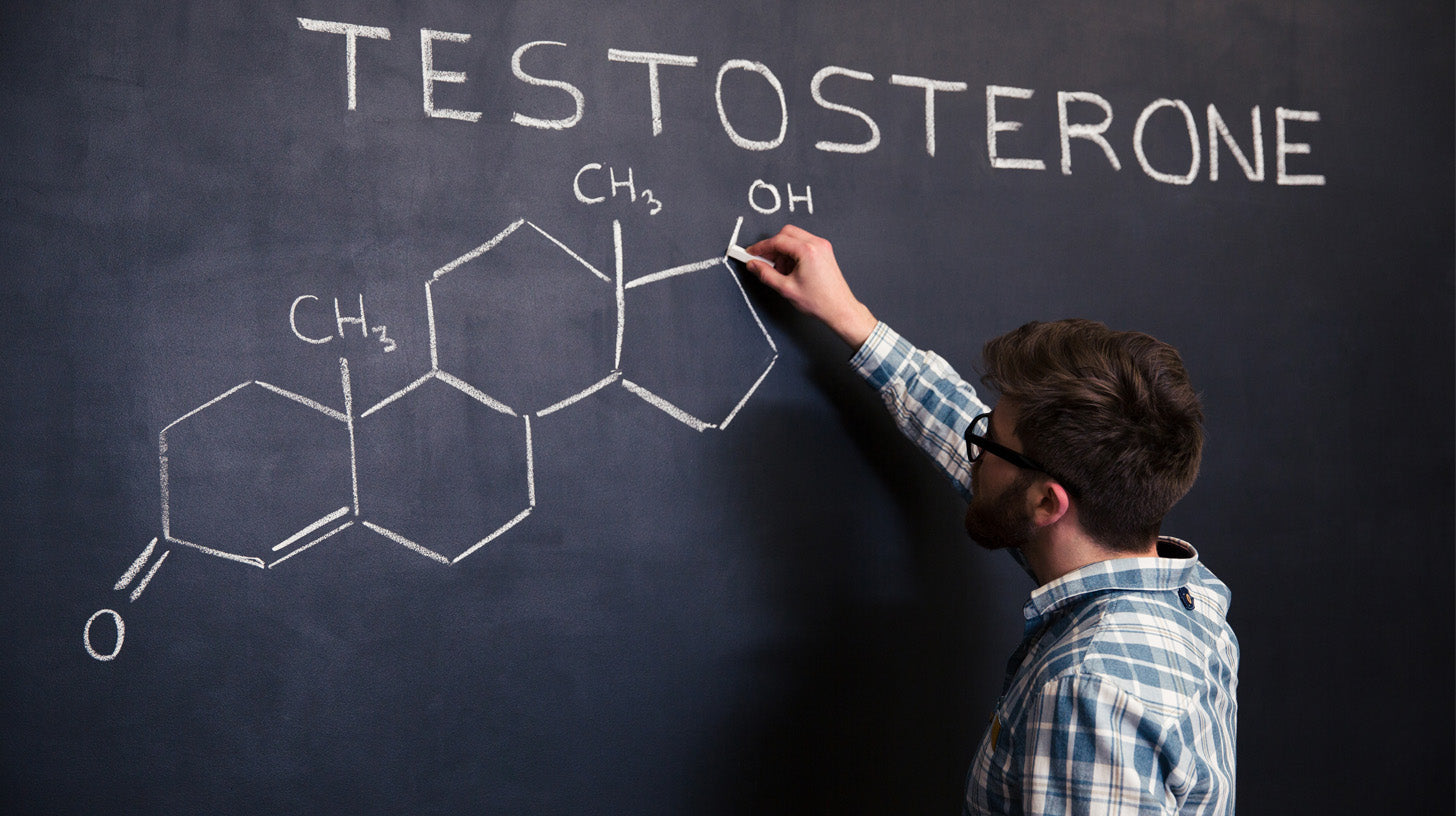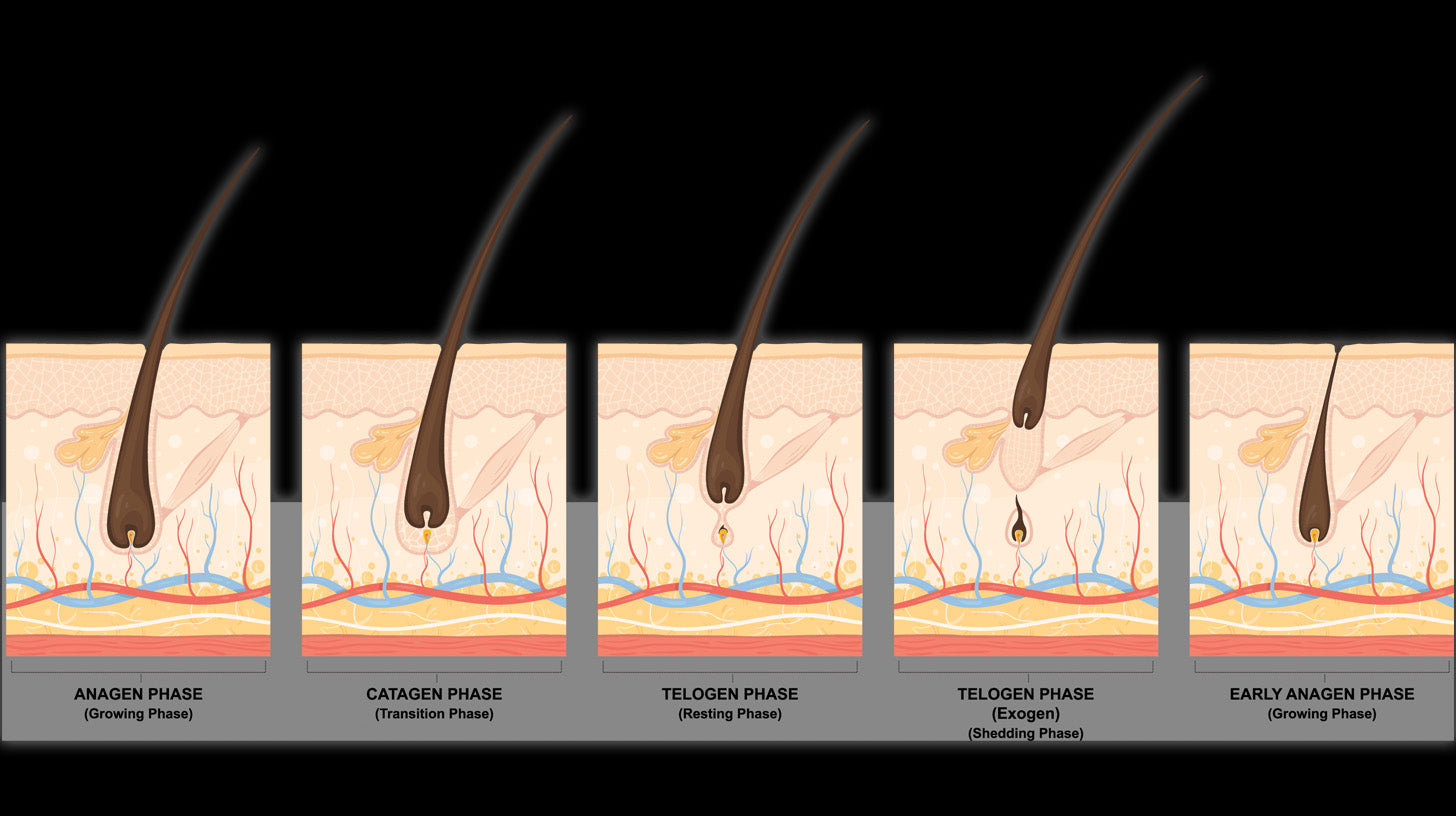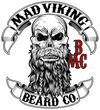Does Testosterone Cause Hair Loss? What To Know

Hair loss is a deeply sensitive issue for a multitude of men worldwide. It's a complex problem that can stem from various factors, including genetics, lifestyle, and health conditions. However, one particular area of interest and debate is the correlation between the male sex hormone, testosterone, and the phenomenon of hair loss.
This comprehensive guide aims to delve deeper into the intricate relationship between testosterone levels and hair loss. We will unpack the scientific theories underlying this connection, examine how changes in hormone levels can impact hair health, and discuss the myriad of treatment options available to those who are concerned about maintaining their mane.
By exploring the latest research, this guide seeks to provide a clearer understanding of how testosterone influences hair loss and what men can do to address this issue.
Introduction to Testosterone and Hair Loss
Testosterone is often associated with male characteristics, but it plays a fundamental role in both men and women. This hormone, primarily produced in the testes in men and the ovaries in women, is responsible for a range of processes, from muscle and bone maintenance to the development of reproductive tissues.
However, when it comes to hair growth, the story isn't quite as simple. Higher levels of testosterone, or more specifically a byproduct of testosterone called dihydrotestosterone (DHT), are linked to hair loss conditions known as androgenic alopecia, or male pattern baldness. It is this correlation that has piqued the interest of many seeking to understand the nuances of their hormonal health and the fate of their follicles.
Understanding the Role of Testosterone in Hair Growth

Hair growth is a complex process that follows a precise cycle composed of three distinct stages: the growth phase, a transitional phase, and a resting phase. The anagen phase, or the growth phase, is particularly crucial for hair development, during which time hair strands actively grow. Testosterone plays a pivotal role in extending this growth phase, thereby promoting longer periods of hair growth. However, when the anagen phase is cut short and the resting phase is extended, the overall hair growth can be significantly reduced, leading to thinner and less dense hair.
Interestingly, it's not the elevated levels of testosterone per se that are directly responsible for hair loss. Instead, the key factor in hair loss is the conversion of testosterone into dihydrotestosterone (DHT) through the action of the enzyme 5-alpha reductase. This conversion process primarily takes place within the hair follicles themselves.
DHT has a stronger affinity for hair follicle receptors than testosterone does, leading to the miniaturization of hair follicles. This miniaturization process is a defining characteristic of androgenetic alopecia, also known as male pattern baldness.
Over time, as hair follicles shrink, they produce progressively thinner and shorter hair strands until, eventually, hair growth may cease altogether in those areas, resulting in baldness. Understanding these mechanisms is crucial for developing effective treatments for hair loss and promoting healthy hair growth.
While the impact of testosterone on scalp hair loss is widely acknowledged, its effect on facial and body hair varies significantly. High levels of testosterone can often promote increased facial hair growth and contribute to denser body hair, highlighting the hormone's contrasting role across different areas of the body.
Testosterone Levels and Benign Prostatic Hyperplasia (BPH)?
Benign Prostatic Hyperplasia (BPH) is a common condition that affects many men as they age. It involves the enlargement of the prostate gland, a crucial component of the male reproductive system. The prostate surrounds the urethra just below the bladder and is responsible for producing fluid that nourishes and transports sperm. When the gland enlarges, it can press against the urethra, causing difficulties with urination, such as increased frequency, urgency, nocturia (needing to urinate during the night), and a weakened stream.
Despite its potential to cause uncomfortable urinary symptoms, it's important to note that BPH is not cancerous and does not increase the risk of prostate cancer. The exact causes of BPH are not entirely understood, but it's believed to be related to changes in hormone levels, including testosterone, as men get older.
Treatment options vary depending on the severity of symptoms, and can include medications, lifestyle changes, or surgical procedures aimed at relieving the symptoms and improving quality of life.
The Relationship Between Testosterone and DHT
DHT, or dihydrotestosterone, represents a more potent variant of testosterone, possessing a higher affinity for androgen receptors located throughout the body. This hormone plays a pivotal role in various physiological processes, but it is particularly notorious for its impact on hair health.
When DHT binds to androgen receptors in the scalp's hair follicles, it initiates a signal that disrupts the natural hair growth cycle. Specifically, this signal extends the follicle's resting phase while concurrently shortening the active growth phase. Over time, this alteration in the hair growth cycle leads to progressively thinner hair strands and, eventually, noticeable hair loss. This mechanism underscores the significant influence of DHT on hair thinning and the overall challenge it presents in maintaining hair density.
How DHT Affects Hair Follicles
The impact of Dihydrotestosterone (DHT) on hair follicles plays a significant role in hair loss. DHT is a hormone that, when attached to hair follicles, causes them to shrink. This shrinkage affects the hair's growth cycle by making it shorter and the hair that does grow, finer and thinner than before.
Over time, the continual exposure to DHT makes the hair follicles enter a dormant state where they cease to produce new hair strands, leading to noticeable hair thinning and potentially resulting in baldness.
Androgenic Alopecia: The Link Between Testosterone and Hair Loss
Androgenic alopecia, often referred to as male pattern hair loss, stands as the predominant cause of hair loss in men, with its roots deeply embedded in genetics. Individuals afflicted with this condition inherit hair follicles that possess a genetic predisposition towards sensitivity to dihydrotestosterone (DHT), a derivative of the male hormone testosterone. This heightened sensitivity to DHT triggers the miniaturization of hair follicles, a process that gradually diminishes their size and ability to produce healthy hair. Over time, this leads to a noticeable thinning of the hair on the scalp, manifesting as receding hairlines and bald spots, characteristics commonly associated with androgenic alopecia.
When Does It Typically Start?
Androgenic alopecia, often known as male or female pattern baldness, can commence as early as the late teens and early twenties, marking a significant concern for many individuals at a young age.
The initial signs of hair loss usually become visible at the temples and the crown of the head, gradually progressing over time. This condition can significantly impact self-esteem and is influenced by a combination of genetic and hormonal factors.
Progression of Hair Loss
The progression of male pattern baldness varies, with some men experiencing a receding hairline that over time joins a bald spot at the crown, while others may notice significant thinning without the classic receding hairline.
Female Pattern Hair Loss and Testosterone
Female pattern hair loss (FPHL), also known as androgenetic alopecia in women, presents unique challenges in understanding and treatment, particularly with its relation to testosterone and other androgens. While testosterone is often considered a male hormone, women also produce it in smaller quantities.
In cases of FPHL, sensitivity to androgens, including testosterone, plays a significant role. This sensitivity can cause the hair follicles to shrink, leading to a decrease in hair density and the characteristic thinning of hair on the scalp.
Unlike men, women typically experience this thinning as a widening of the part or a more diffuse loss across the top of the scalp, rather than a receding hairline or bald spots. Management and treatment require a careful approach, balancing hormone levels while considering the unique aspects of female physiology.

Other Factors Contributing to Hair Loss
While DHT and genetics are significant players in male pattern baldness, they are not the only factors at work.
Genetic Predisposition and Sensitivity to DHT
Genes inherited from both the mother and father's side play a significant role in influencing hair loss. The sensitivity to dihydrotestosterone (DHT), a derivative of the male hormone testosterone, is inherited. This sensitivity means that the more DHT circulates in the blood, the more likely it is for hair loss to occur in individuals who have a higher genetic predisposition to this condition.
Essentially, these genetic factors dictate how hair follicles respond to DHT, with those inheriting a higher sensitivity experiencing more pronounced hair loss.
Lifestyle Factors and Environmental Influences
Environmental factors and lifestyle choices are significant contributors to hair loss. High levels of stress, the harmful habit of smoking, inadequate nutrition lacking in essential vitamins and minerals, and certain medical conditions such as thyroid disorders or hormonal imbalances can all accelerate the balding process.
Moreover, overusing hair styling products and tools that apply heat or chemicals directly to the scalp can further damage hair follicles, leading to increased hair loss. Ensuring a healthy, balanced diet rich in nutrients, effectively managing stress levels through techniques such as meditation or exercise, and avoiding unnecessary exposure to hair-damaging elements such as harsh chemicals or extreme heat can all play a crucial role in maintaining a healthy head of hair.
Additionally, consulting with healthcare professionals to address any underlying medical issues can also help in preventing further hair loss.
Treatment Options for Testosterone-Related Hair Loss
Understanding the complexities of the interplay between testosterone and hair health can help men make informed decisions about their well-being. There are several treatment options available for those experiencing testosterone-related hair loss.
Medication
Medications such as minoxidil and finasteride have shown promising results in slowing down, halting, or even reversing the effects of androgenetic alopecia, a common form of hair loss in both men and women. Minoxidil, when applied as a topical solution, works by extending the length of the anagen phase, or the active growing phase of hair, thereby promoting hair growth and thickness.
On the other hand, finasteride operates by targeting the 5-alpha-reductase enzyme, significantly reducing the enzyme's ability to convert testosterone into dihydrotestosterone (DHT), a hormone known to contribute to hair loss by shrinking hair follicles. Together, these medications offer a two-pronged approach to tackling hair loss by stimulating hair growth and preventing further hair thinning.
Hair Transplantation
For individuals in search of a more lasting resolution to hair loss, hair transplantation presents a viable long-term remedy. In this process, hair follicles from the denser areas of the scalp, often referred to as the donor sites, are carefully harvested and then transplanted to the balding areas. This method allows the transplanted hair to integrate naturally and effectively with the existing hair, promoting a uniform growth pattern over time and significantly improving the overall appearance of the scalp.
Testosterone Replacement Therapy
Testosterone replacement therapy (TRT) can offer several potential benefits for those suffering from low testosterone levels, which might be contributing to hair loss and other health issues. Primarily, TRT aims to restore testosterone levels to a normal range, which can lead to improved mood, increased energy levels, and a more vibrant libido.
Additionally, this therapy can enhance muscle strength and bone density, factors crucial for overall physical health. In the context of hair loss, while testosterone replacement therapy is generally not prescribed directly for treating androgenic alopecia, normalizing testosterone levels in the body can potentially improve the overall health of hair for those individuals where low testosterone is indirectly impacting hair quality and growth.
It's essential, however, to approach TRT with caution, as it can exacerbate hair loss in some by increasing levels of DHT, especially in those with a genetic predisposition to androgenic alopecia.
Consulting with healthcare professionals to carefully weigh the benefits against the risks is crucial for anyone considering testosterone replacement therapy as part of their health regimen.
Low-Level Laser Therapy (LLLT)
This innovative treatment employs a specialized device that emits low levels of light, which is directed precisely onto the scalp. Known as Low-Level Laser Therapy (LLLT), this technique is gaining traction in the medical community for its potential to stimulate the sensitive hair follicles, thereby promoting the growth of new hair. It is particularly considered beneficial for individuals suffering from androgenic alopecia, a common form of hair loss.
By enhancing cellular activity in the hair follicles, LLLT aims to counteract the effects of this condition, offering hope for those seeking to restore their hair's density and vitality.
Multivitamins and Their Role in Hair Health

Multivitamins play a pivotal role in promoting hair health and combating hair loss. A balanced intake of essential vitamins and minerals can address nutritional deficiencies that are often at the root of hair thinning and loss. Vitamins such as Biotin (Vitamin B7), commonly heralded for its hair growth properties, alongside Vitamin D, Vitamin E, and iron, contribute significantly to the strengthening of hair follicles and stimulation of hair growth. These nutrients aid in the production of red blood cells, which carry oxygen to the scalp and hair follicles, thereby optimizing the hair’s natural growth cycle and improving its overall health.
Furthermore, antioxidants found in Vitamins C and E can protect the scalp and hair from oxidative stress caused by free radicals, which can lead to premature hair aging and weakening. By incorporating a comprehensive multivitamin into their daily routine, individuals may see a reduction in hair loss and an improvement in hair texture and volume.
Nevertheless, it’s essential to consult with healthcare professionals before starting any new supplement regime, especially to address specific health concerns such as hair loss, to ensure the chosen multivitamins are in alignment with one's health and well-being goals.
Cosmetic Solutions
Cosmetic techniques, such as employing hairpieces and wigs or applying topical treatments directly to the scalp, offer temporary solutions for individuals grappling with the visual effects of male pattern baldness. These methods can help conceal hair loss and improve appearance, providing a boost in confidence for those affected by this common condition.
Conclusion: Understanding the Complexities of Testosterone and Hair Loss
While the debate continues on the extent of testosterone's role in hair loss, it's evident that it's a complex and multifaceted issue. Genetic predispositions, environmental factors, and individual sensitivities to androgenic hormones all play a part in determining the health of one's hair.
For some, the prospect of balding can be distressing, but it's essential to remember that there are proactive steps that can be taken to treat hair loss. Whether it's through medical intervention, changes in lifestyle, or simply accepting the natural course of aging, men have options to approach the issue.
Understanding the science behind testosterone and its links to hair health can empower men to take control of their bodies and make choices that align with their personal definitions of health and well-being. It's not just about combating hair loss — it's about understanding the marvel that is the human body, and the beauty that comes with acknowledging and nurturing it in every stage of our lives.


Leave a comment